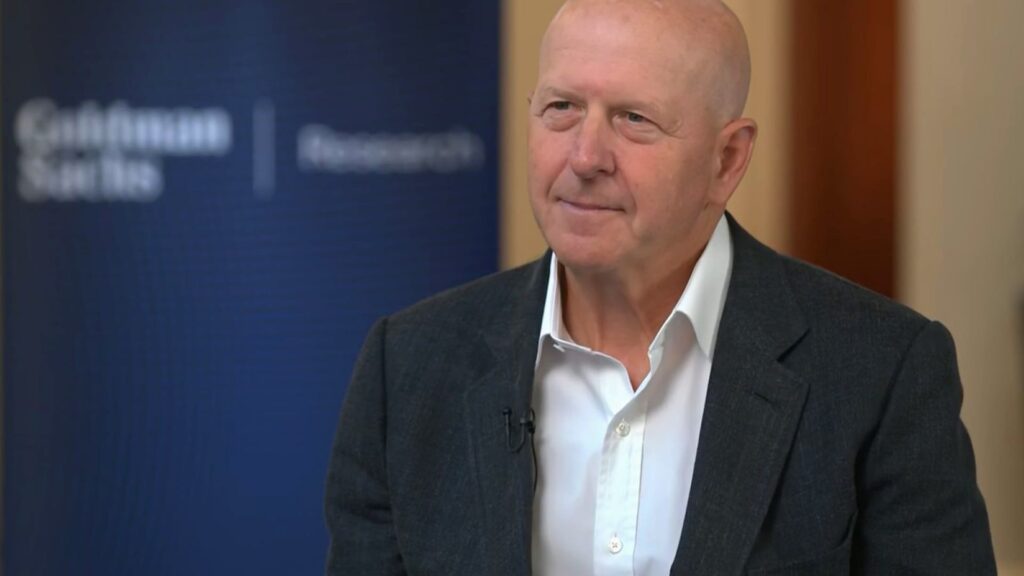
Goldman Sachs Earnings Q1 2025: Strong Trading Revenue Drives Profit Growth
Goldman Sachs Earnings Q1 2025: Strong Trading Revenue Drives Profit Growth
Published on April 20, 2025
David Solomon, CEO of Goldman Sachs, testifies during a Senate Banking Committee hearing in Washington, D.C. | Photo Credit: Win McNamee | Getty Images
Table of Contents
The Goldman Sachs earnings Q1 2025 results exceeded analyst expectations as the investment banking giant reported significant profit growth driven by robust trading revenue. The firm’s performance, particularly in equities trading, helped offset weaknesses in other divisions amid escalating market volatility tied to trade tensions.
Goldman Sachs Q1 2025 Headline Figures
The Goldman Sachs earnings Q1 2025 report released Monday showed impressive profit growth, with earnings per share and revenue both surpassing Wall Street forecasts. The bank reported earnings of $14.12 per share against analyst expectations of $12.35, representing a 15% year-over-year increase that brought quarterly profit to $4.74 billion.
Key Financial Metrics
| Metric | Q1 2025 Result | Analyst Estimate | YoY Change |
|---|---|---|---|
| Earnings Per Share | $14.12 | $12.35 | +15% |
| Revenue | $15.06 billion | $14.81 billion | +6% |
| Net Income | $4.74 billion | N/A | +15% |
Revenue growth was more modest at 6%, reaching $15.06 billion compared to the projected $14.81 billion. This performance demonstrates Goldman Sachs’ ability to expand profit margins even in a challenging business environment. The Goldman Sachs earnings Q1 2025 results prompted a 2.2% rise in the bank’s shares during morning trading despite the stock having fallen 14% year-to-date.
Equities Trading Performance
The standout element of the Goldman Sachs earnings Q1 2025 report was the exceptional performance in equities trading. Revenue in this division surged 27% year-over-year to $4.19 billion, exceeding analyst expectations by approximately $540 million.
Equities Trading Success Factors
- Market Volatility: Heightened trading activity driven by uncertainty around trade policies
- Positioning Adjustments: Institutional clients rebalancing portfolios in response to policy shifts
- Trading Expertise: Goldman’s strong execution capabilities during turbulent market conditions
- Client Engagement: Increased activity from hedge funds and asset managers seeking to capitalize on market dislocations
This robust equities trading performance mirrors similar results from other major Wall Street banks. The exceptional trading revenue helped offset weaknesses in other segments and underscores the crucial role of trading operations in the Goldman Sachs earnings Q1 2025 results.
Divisional Performance Analysis
While equities trading drove the Goldman Sachs earnings Q1 2025 outperformance, results across the firm’s various divisions showed mixed performance. The global banking and markets division, which houses the trading operations, recorded a 10% increase in revenue to $10.71 billion.
Divisional Performance Breakdown
| Division/Segment | Q1 2025 Revenue | Analyst Estimate | YoY Change | Performance vs. Estimate |
|---|---|---|---|---|
| Global Banking & Markets | $10.71 billion | N/A | +10% | N/A |
| Equities Trading | $4.19 billion | $3.65 billion | +27% | Beat by $540 million |
| Fixed Income Trading | $4.4 billion | $4.56 billion | +2% | Missed by $160 million |
| Investment Banking | $1.91 billion | $1.94 billion | -8% | Missed by $30 million |
| Asset & Wealth Management | $3.68 billion | $3.69 billion | -3% | Missed by $10 million |
| Platform Solutions | $676 million | $677.5 million | -3% | Missed by $1.5 million |
The fixed income trading division showed modest 2% growth to $4.4 billion but fell short of analyst expectations. Investment banking fees declined 8% to $1.91 billion, reflecting lower advisory revenue as clients delayed transaction decisions amid uncertain market conditions.
Asset and wealth management revenue decreased 3% to $3.68 billion, which Goldman attributed to “significantly lower” revenue from investments including private equity, public stock, and debt holdings. The platform solutions division also saw a 3% revenue decline to $676 million. These results highlight the critical role that equities trading played in the overall Goldman Sachs earnings Q1 2025 performance.
Market Volatility Impact
The Goldman Sachs earnings Q1 2025 results reflect a period of significant market upheaval driven by escalating trade tensions. Markets have experienced substantial volatility as President Donald Trump intensified trade conflicts with U.S. trading partners, creating both opportunities and challenges for financial institutions.
Market Environment Factors
The first quarter of 2025 saw financial markets respond dramatically to policy shifts:
- Trade Tension Escalation: Presidential actions targeting key trading partners created market uncertainty
- Corporate Decision Delays: CEOs paused strategic initiatives amid unclear policy direction
- Portfolio Repositioning: Institutional investors adjusted exposures to protect against potential trade war impacts
- Sector Rotation: Money flowed between sectors perceived as vulnerable to or benefiting from trade policies
- Heightened Volatility: VIX and other volatility measures increased significantly during the quarter
While this volatility benefited Goldman’s trading operations, it simultaneously suppressed deal-making activity as corporate leaders adopted a wait-and-see approach. This dynamic is evident in the Goldman Sachs earnings Q1 2025 figures, with trading revenue surging while investment banking fees declined.
Executive Commentary
In the Goldman Sachs earnings Q1 2025 release and subsequent analyst call, CEO David Solomon addressed the challenging market environment and its impact on client behavior. His comments highlighted the tension between the trading opportunities created by volatility and the hesitancy it generates among corporate clients.
Key Executive Statements
- “While we are entering the second quarter with a markedly different operating environment than earlier this year, we remain confident in our ability to continue to support our clients.” – David Solomon in earnings release
- “In investment banking, the volatile backdrop led to more muted activity relative to the levels we had expected coming into the year.” – Solomon to analysts
- “Our clients, including corporate CEOs and institutional investors, are concerned by the significant near-term and longer term uncertainty that has constrained their ability to make important decisions.” – Solomon on client sentiment
- “This uncertainty around the path forward, and fears over the potentially escalating effects of a trade war have created material risks to the US and global economy.” – Solomon on economic outlook
Solomon’s comments suggest that while the Goldman Sachs earnings Q1 2025 results benefited from market volatility in the short term, the firm recognizes potential long-term risks to economic growth if trade tensions continue to escalate. This cautious outlook may explain why Goldman’s stock has underperformed this year despite the strong quarterly results.
Industry Comparison
The Goldman Sachs earnings Q1 2025 results follow similar reports from competitors JPMorgan Chase and Morgan Stanley, which also reported strong first-quarter performances driven by equities trading. This pattern underscores how market volatility has benefited the trading operations of major Wall Street firms.
Equities Trading Revenue Comparison
| Bank | Equities Trading YoY Growth | Q1 2025 Equities Revenue |
|---|---|---|
| JPMorgan Chase | +48% | ~$4.2 billion |
| Morgan Stanley | +45% | ~$4.1 billion |
| Goldman Sachs | +27% | $4.19 billion |
While Goldman’s equities trading growth was impressive at 27%, it lagged behind the even more dramatic increases reported by JPMorgan (48%) and Morgan Stanley (45%). However, all three firms demonstrated how their trading operations could capitalize on market disruptions stemming from policy changes.
The strong trading results across Wall Street in the Goldman Sachs earnings Q1 2025 reporting season highlight how periods of uncertainty can generate significant revenue opportunities for sophisticated financial institutions, even as they create challenges for other aspects of their businesses.
As markets continue to digest ongoing policy shifts and potential economic impacts, Goldman Sachs’ ability to maintain trading revenue while potentially reviving investment banking activity will be crucial to its performance in upcoming quarters.
Published on April 20, 2025 | Updated on April 20, 2025






